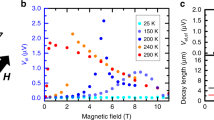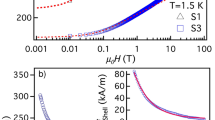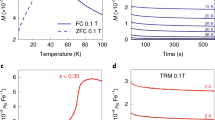Abstract
Interest in magnetic nanoparticles has increased in the past few years by virtue of their potential for applications in fields such as ultrahigh-density recording and medicine1,2,3,4. Most applications rely on the magnetic order of the nanoparticles being stable with time. However, with decreasing particle size the magnetic anisotropy energy per particle responsible for holding the magnetic moment along certain directions becomes comparable to the thermal energy. When this happens, the thermal fluctuations induce random flipping of the magnetic moment with time, and the nanoparticles lose their stable magnetic order and become superparamagnetic5. Thus, the demand for further miniaturization comes into conflict with the superparamagnetism caused by the reduction of the anisotropy energy per particle: this constitutes the so-called ‘superparamagnetic limit’6,7 in recording media. Here we show that magnetic exchange coupling induced at the interface between ferromagnetic and antiferromagnetic systems8,9 can provide an extra source of anisotropy, leading to magnetization stability. We demonstrate this principle for ferromagnetic cobalt nanoparticles of about 4 nm in diameter that are embedded in either a paramagnetic or an antiferromagnetic matrix. Whereas the cobalt cores lose their magnetic moment at 10 K in the first system, they remain ferromagnetic up to about 290 K in the second. This behaviour is ascribed to the specific way ferromagnetic nanoparticles couple to an antiferromagnetic matrix.
This is a preview of subscription content, access via your institution
Access options
Subscribe to this journal
Receive 51 print issues and online access
$199.00 per year
only $3.90 per issue
Buy this article
- Purchase on Springer Link
- Instant access to full article PDF
Prices may be subject to local taxes which are calculated during checkout




Similar content being viewed by others
References
Kodama, R. H. Magnetic nanoparticles. J. Magn. Magn. Mater. 200, 359–372 (1999)
Martín, J. I. et al. Ordered magnetic nanostructures: Fabrication and properties. J. Magn. Magn. Mater. 256, 449–501 (2003)
Sun, S. H. et al. Monodisperse FePt nanoparticles and ferromagnetic FePt nanocrystal superlattices. Science 287, 1989–1992 (2000)
Häfeli, U., Schütt, W., Teller, J. & Zborowski, M. (eds) Scientific and Clinical Applications of Magnetic Materials (Plenum, New York, 1997)
Chikazumi, S. Physics of Ferromagnetism (Oxford Univ. Press, New York, 1997)
Weller, D. & Moser, A. Thermal effect limits in ultrahigh-density magnetic recording. IEEE Trans. Magn. 35, 4423–4439 (1999)
Thompson, D. A. & Best, J. S. The future of data storage technology. IBM J. Res. Dev. 44, 311–322 (2000)
Meiklejohn, W. H. & Bean, C. P. New magnetic anisotropy. Phys. Rev. 102, 1413–1414 (1956)
Nogués, J. & Schuller, I. K. Exchange bias. J. Magn. Magn. Mater. 192, 203–232 (1999)
Huberland, H. et al. Thin film growth from energetic cluster impact: A feasibility study. J. Vac. Sci. Technol. A 10, 3266–3271 (1992)
Gangopadhyay, S. et al. Exchange anisotropy in oxide passivated Co fine particles. J. Appl. Phys. 73, 6964–6966 (1993)
Luis, F. et al. Magnetic relaxation of interacting Co clusters: Crossover from two- to three-dimensional lattices. Phys. Rev. Lett. 88, 217205 (2002)
García-Otero, J. et al. Influence of dipolar interaction on magnetic properties of ultrafine ferromagnetic particles. Phys. Rev. Lett. 84, 167–170 (2000)
Gu, E. et al. Two-dimensional paramagnetic-ferromagnetic phase transition and magnetic anisotropy in Co(110) epitaxial nanoparticle arrays. Phys. Rev. B 60, 4092–4095 (1999)
Parent, F. et al. Giant magnetoresistance in Co-Ag granular films prepared by low-energy cluster beam deposition. Phys. Rev. B 55, 3683–3687 (1997)
Held, G. A. et al. Competing interactions in dispersions of superparamagnetic nanoparticles. Phys. Rev. B 64, 012408 (2001)
Woods, S. I. et al. Direct investigation of superparamagnetism in Co nanoparticle films. Phys. Rev. Lett. 87, 137205 (2001)
Murray, C. B. et al. Monodisperse 3d transition-metal (Co,Ni,Fe) nanoparticles and their assembly into nanoparticle superlattices. Mater. Res. Soc. Bull. 26, 985–991 (2001)
Sako, S., Osshima, K. & Saki, M. Magnetic property of oxide passivated Co nanosized particles dispersed in two dimensional plane. J. Phys. Soc. Jpn 70, 2134–2138 (2001)
Lund, M. S. et al. Effect of anisotropy on the critical antiferromagnetic thickness in exchange biased bilayers. Phys. Rev. B 66, 054422 (2002)
Peng, D. L. et al. Magnetic properties of monodispersed Co/CoO clusters. Phys. Rev. B 61, 3103–3109 (2000)
Sort, J. et al. Room temperature coercivity enhancement in mechanically alloyed antiferromagnetic-ferromagnetic powders. Appl. Phys. Lett. 75, 3177–3179 (1999)
Liu, K. et al. Fabrication and thermal stability of arrays of Fe nanodots. Appl. Phys. Lett. 81, 4434–4436 (2002)
Jensen, P. J. Magnetic recording medium with improved temporal stability. Appl. Phys. Lett. 78, 2190–2192 (2001)
Schulthess, T. C. & Butler, W. H. Consequences of spin-flop coupling in exchange biased films. Phys. Rev. Lett. 81, 4516–4519 (1998)
Stamps, R. L. Mechanisms for exchange bias. J. Phys. D 33, R247–R268 (2000)
Kanamori, J. Theory of the magnetic properties of ferrous and cobaltous oxides. Prog. Theor. Phys. 17, 177–196 (1957)
Takano, K. et al. Interfacial uncompensated antiferromagnetic spins: Role of unidirectional anisotropy in polycrystalline Ni81Fe19/CoO bilayers. Phys. Rev. Lett. 79, 1130–1133 (1997)
Kodama, R. H., Makhlouf, S. H. & Berkowitz, A. E. Finite size effects in antiferromagnetic NiO nanoparticles. Phys. Rev. Lett. 79, 1393–1396 (1997)
Coey, J. M. D. Noncollinear spin arrangement in ultrafine ferrimagnetic crystallites. Phys. Rev. Lett. 27, 1140–1143 (1971)
Acknowledgements
We thank N. Dempsey for critical reading of the manuscript, and D. Weller for discussions. This work was partly supported by the US National Science Foundation, Seagate Technology, the Catalan Direcció General de Recerca, and the Spanish Comisión Interministerial de Ciencia y Tecnología.
Author information
Authors and Affiliations
Corresponding author
Ethics declarations
Competing interests
The authors declare that they have no competing financial interests.
Rights and permissions
About this article
Cite this article
Skumryev, V., Stoyanov, S., Zhang, Y. et al. Beating the superparamagnetic limit with exchange bias. Nature 423, 850–853 (2003). https://doi.org/10.1038/nature01687
Received:
Accepted:
Published:
Issue Date:
DOI: https://doi.org/10.1038/nature01687
This article is cited by
-
Tuning exchange bias in silica-coated Co-CoO core-shell nanostructure
Journal of Nanoparticle Research (2024)
-
Absence of a pressure gap and atomistic mechanism of the oxidation of pure Co nanoparticles
Nature Communications (2023)
-
Exchange bias effect in polycrystalline Bi0.5Sr0.5Fe0.5Cr0.5O3 bulk
Scientific Reports (2023)
-
An exhaustive scrutiny to amplify the heating prospects by devising a core@shell nanostructure for constructive magnetic hyperthermia applications
Scientific Reports (2023)
-
Magnetic super-structure and active surface role in the onset of magnetic excitons revealed in TbCu2 nanoparticles
Communications Materials (2023)
Comments
By submitting a comment you agree to abide by our Terms and Community Guidelines. If you find something abusive or that does not comply with our terms or guidelines please flag it as inappropriate.



